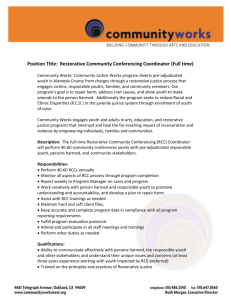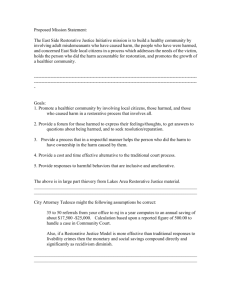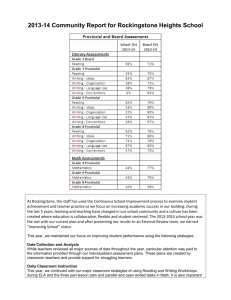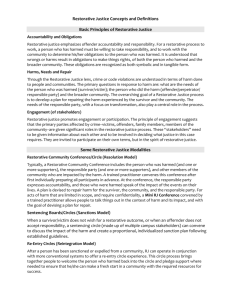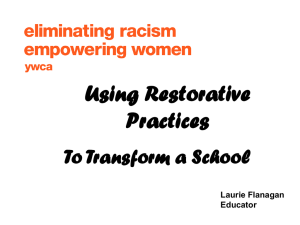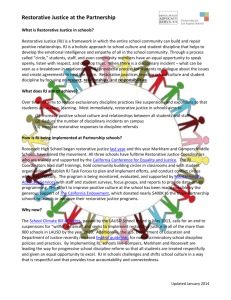13-14 Intro to RP Presentation Resource Packet
advertisement
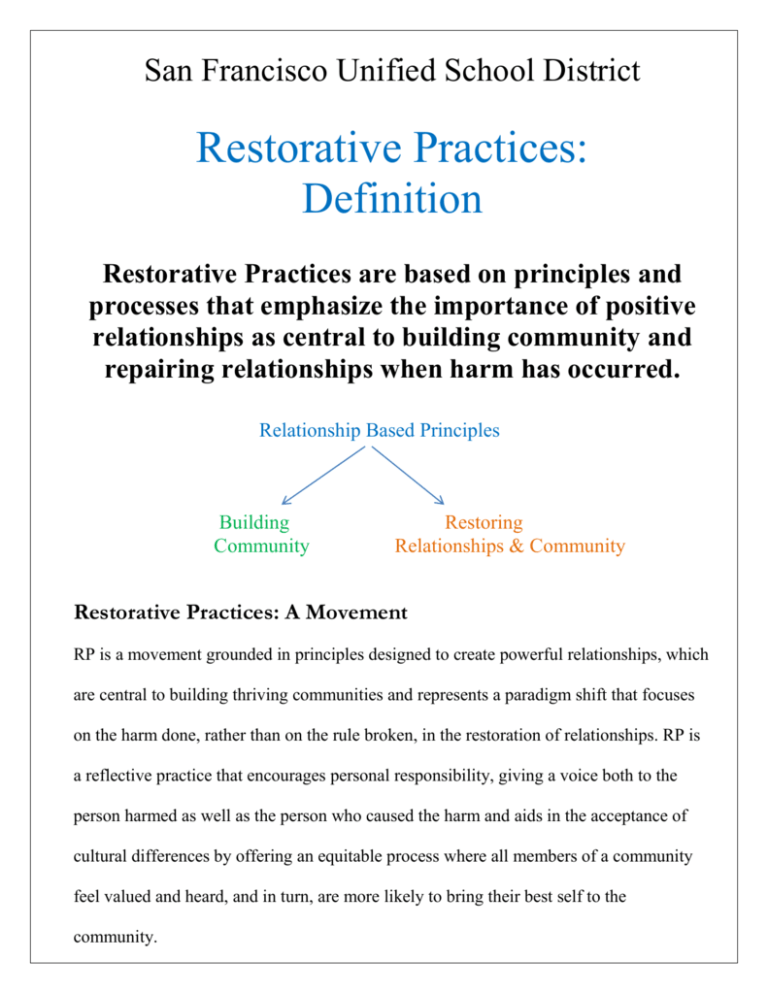
San Francisco Unified School District Restorative Practices: Definition Restorative Practices are based on principles and processes that emphasize the importance of positive relationships as central to building community and repairing relationships when harm has occurred. Relationship Based Principles Building Community Restoring Relationships & Community Restorative Practices: A Movement RP is a movement grounded in principles designed to create powerful relationships, which are central to building thriving communities and represents a paradigm shift that focuses on the harm done, rather than on the rule broken, in the restoration of relationships. RP is a reflective practice that encourages personal responsibility, giving a voice both to the person harmed as well as the person who caused the harm and aids in the acceptance of cultural differences by offering an equitable process where all members of a community feel valued and heard, and in turn, are more likely to bring their best self to the community. Restorative Practices in SFUSD Restorative Practices, when broadly and consistently implemented, will promote and strengthen positive school culture and enhance pro-social relationships within the school community. Restorative practices allow for a shift in practice that results in a culture which is inclusive, builds fair process into decision-making practices, and facilitates students learning to address the impact of their actions through an approach that allows for true accountability, skill building, cooperation, and mutual understanding. Through restorative practices, members of the school community will: 1. have an opportunity to be heard 2. understand the greater impact of one's actions 3. learn to take responsibility 4. repair the harm one's actions may have caused 5. recognize one's role in maintaining a safe school environment 6. build upon and expand on personal relationships in the school community 7. recognize one's role as a positive contributing member of the school community. Ultimately, people will learn to make positive, productive, and effective choices in response to situations they may encounter in the future after engaging in a restorative practice. The underlying premise of restorative practices is that people are happier, more cooperative, more productive and more likely to make positive changes when those in positions of authority do things with them rather than to them or for them. A Response to, and Prevention of Harm In schools, Restorative Practice/Approaches are multifaceted in nature. Restorative practices include interventions when harm has happened, as well as practices that help to prevent harm and conflict by helping to build a sense of belonging, safety, and social responsibility in the school community. Benefits of Restorative Approaches in the School Setting * A safer, more caring environment. * A more effective teaching and learning environment. * A greater commitment by everyone to taking the time to listen to one another. * A reduction in bullying and other interpersonal conflicts. * A greater awareness of the importance of connectedness to young people. The need to belong and feel valued by peers and significant adults. *Greater emphasis on responses to inappropriate behavior that seek to reconnect, and not further disconnect young people. * Reductions in fixed term and permanent suspensions and expulsions. * A greater confidence in the staff team to deal with challenging situations. At the core, restorative practices is about building and restoring relationships. Community Creating a Sense of Belonging and Value in a Group Components of Community formation: Gibbsm J. (2001), Discovering Gifts in Middle School: Tribes, CA CenterSource Systems p. 74 1. Capacity: Communities are built upon recognizing the whole depth, the strengths, weaknesses, and the unique capacities of each member. 2. Collective Effort: Communities share responsibility to achieve goals for the common good, and to engage the diversity of individual talents and skills. 3. Informality: Interactions are based on consideration; care and affection take place spontaneously. 4. Stories: Reflection upon individual and community experiences provides knowledge about truth, relationships and further direction. “To build a sense of community is to create a group that extends to others the respect one has for oneself, to come to know one another as individual, to respond and care about one another, to feel a sense of membership and accountability to the group.” Thomas Likona, author on moral development and education SFUSD Restorative Principles The following principles reflect the values and concepts for implementing restorative practices in the school setting. Under each principle are some of its important implications. Restorative Practices: 1. Acknowledges that relationships are central to building community. Considerable effort and time is spent on building and sustaining positive, trusting relationships among ALL members of the school community. Every student, teacher, administrator, staff member, and parent/guardian is a valued member of the school community. All members of the school community are involved in a process of naming the values and principles to live by within their school community. 2. Ensures equity of voice among all members of the community. All voices are valued, everyone is heard. Systems and structures are established to ensure that all members of the school community have equal opportunities for meaningful participation. A culture of non-judgmental, authentic listening and sharing is encouraged and reinforced. Inclusive decision making practices are utilized to ensure that those impacted by decisions have a voice in the process by providing opportunities for input. Once decisions are made the reason for the decision and new expectations are clearly communicated. Negotiation and cooperation are key components towards building a collaborative classroom and school environment. 3. Establishes a culture of high expectations with high support, emphasizing doing things “WITH” not “TO” or “FOR”. Supports high standards and expectations for both learning and behavior in the school and classroom community, AND offers high levels of support to create positive change = Doing “WITH”. 4. Builds systems that address misbehavior and harm in a way that strengthens relationships and focuses on the harm done rather than only rule-breaking. Schools establish policies to provide a safe place for learning. Real safety however comes from fostering and maintaining caring relationships. Misbehavior is recognized as an offense against people and relationships, not just rulebreaking. Policies need to address the root causes of discipline concerns rather than only the symptoms. The causes of misbehavior may be multiple and should be addressed by all members of the school community equally asserting high levels of expectation within a supportive environment. The person/s harmed is the center of the primary relationship that needs to be addressed. Secondary relationships that may have been impacted might include other students, teachers, parents, the administration, and the surrounding community. 5. Engages in collaborative problem solving. There is a shared responsibility and participation among all members of the school community to contribute to the sustainability of positive relationships by working together to identify potential problems and determine solutions. Misbehavior can become a teachable moment and the community/relationships can be restored when all those impacted/harmed by an incident are involved in a collaborative process of determining unmet needs and solutions to make things as right as possible. Recognizes all of us act to satisfy our human needs (ex. belonging, freedom, power, and fun). Behaviors are chosen to meet these underlying needs. 6. Enhances accountability, responsibility and empowers change and growth for all members of the community. All members of the school community are responsible for contributing to the establishment and sustaining of a positive school culture by taking personal responsibility to follow through and hold one another accountable to the collective values and principles that define the community. Conflict presents opportunity for change if the process includes careful listening, reflecting, shared problem-solving, and trust. High accountability occurs when systems and structures are in place that allow for one to take responsibility for their actions by providing them the opportunity to learn and understand the impact of their actions, determine how to make things as right as possible, AND follow through with the plan. Consequences as part of the restorative process should be evaluated based on whether they are reasonable, related to the offense, and respectful. Some students choose to resist participation in a process that will allow for change and may need adults to support and guide them in decision-making concerning their accountability. Modified from Amstutz, L., & Mullet, J., (2005), pg 29-32.The Little Book of Restorative Discipline, pg 26-28 Restorative Discipline You are working toward restorative discipline in schools when you…. 1. Focus primarily on relationships and secondarily on rules. □ Does the proposed response go beyond focusing solely on policy violations? Is equal concern also being given to harm experienced by individuals and the community? □ What steps are being implemented to ensure the safety of the individuals involved while information is being gathered? □ Have support people (e.g. an advocate, mentor, or other person deemed appropriate given the circumstances) been identified, approved by, and provided for each person involved? □ Are needed resources available for all persons involved, i.e. transportation, childcare, an interpreter, accessibility? □ Has the issue of whether or not to maintain confidentiality within the process and the findings been addressed? □ How will information be shared more broadly if necessary? Are there mandated reporting issues? 2. Give voice to the person(s) harmed? □ Does the response address the needs of the person harmed, both the immediate victim as well as others who many be affected? □ Does the response allow an opportunity for those harmed to be part of the resolution? □ Has the person harmed been asked what s/he needs? □ Has the person harmed been asked what a just process would look like? 3. Give voice to the person(s) who caused the harm. □ Has the person who harmed been asked what s/he needs? □ Does the response address the needs of the person who did the harm? □ Does it allow an opportunity for those who harmed to be part of the resolution? □ Has the person who harmed been asked what s/he can give/offer? □ Has the person who harmed been asked what a just process would look like? 4. Engage in collaborative problem-solving. □ Are the solutions being arrived at collaboratively, meaning that all those affected by the harm/incident are fully involved? □ Are all participants represented at the decision-making table? □ Are all decisions reached collaboratively, with assurance that all voices are heard? □ Given the imbalances that often exist between person and institutions, have these been recognized, acknowledged, discussed, and addressed? 5. Enhance Responsibility. □ Does the response help the person take responsibility for the harm caused, or does it focus primarily on punishment. □ Does the person who caused the harm understand how his/her actions have affected other people? If not, is there a plan in place that includes steps to assist the person in a process of understanding (which may include education on a particular issue, counseling, or training)? □ Is there acknowledgment that some persons choose to resist change and need others to assist in making decisions regarding their accountability? The consequences in that case may need to be made or suggested by others involved in decision-making. 6. Empower Change and Growth. □ Does the response allow the person who harmed to be involved in the process of repair with a concern toward that individual’s growth and competency? □ Has the individual acknowledged responsibility for the harm of his/her actions? If not, what steps should be taken to address ways of meeting and supporting that person’s need for growth? 7. Plan for Restoration. □ Does the response allow for the person who harmed, as well as the person harmed, to be supported and reintegrated back into the community? □ Has the issue of accountability been appropriately addressed to the satisfaction of the person harmed? □ Has a process been developed that ensures ongoing accountability if an agreement for next steps is reached? □ Is there recognition that one possible solution is a “parting of ways” (or setting procedures to avoid interaction), in an effort to give primary consideration to the needs of the person harmed? All material is taken directly from: Amstutz, L., & Mullet, J., (2005), pg 29-32.The Little Book of Restorative Discipline, pg 28-32. Paradigm Shift “What’s fundamental about restorative justice (practices) is a shift away from thinking about laws being broken, who broke the law, and how we punish the people who broke the laws. There’s a shift to: there was harm caused, or there’s disagreement or dispute, there’s conflict, and how do we repair the harm, address the conflict, meet the needs, so that relationships and community can be repaired and restored. It’s a different orientation. It is a shift.” Cheryl Graves - Community Justice for Youth Institute Paradigm Shift: relationship based Traditional Approach Restorative Approach School and rules violated People and relationships violated Justice focuses on establishing guilt Justice identifies needs and obligations Accountability = punishment Accountability = understanding impact, repairing harm Justice directed at person who caused harm, person who experienced harm ignored Person who caused harm, person who experienced harm and school all have direct roles in justice process Rules and intent outweigh whether outcome is positive/negative Person who caused harm is responsible for harmful behavior, repairing harm and working toward positive outcomes No opportunity for remorse or amends Opportunity given for amends and expression of remorse The Social Discipline Window The underlying premise of Restorative Practices rests with the belief that people will make positive changes when those in positions of authority do things with them rather than to them or for them. According to the Social Discipline Window, a restorative approach requires a balance of high levels of control/limit setting with high levels of support, encouragement, and nurture. TO WITH Punitive RESTORATIVE NOT FOR Neglectful Permissive High control and Low support = Punitive/Authoritarian Low control and Low support = Neglectful High support and Low control = Permissive High support and High control = RESTORATIVE Wachtel & Costello (2009), The Restorative Practices Handbook, International Institute for Restorative Practices, pg 50 SFUSD Restorative Practices Language Embracing Restorative Practices as a common, consistent language among the school staff community is a simple and effective approach to reinforce the core values of community, relationships, responsibility and accountability. The words highlighted represent the key language of Restorative Practices. We are a community. Recognizing that the strength and health of the community (among students, staff, and families) directly impacts school climate (sense of belonging and connectedness) and academic achievement. Every member of the community is important and contributes greatly. Each person’s actions affect the health of the community in a positive or negative way. Recommendation: constantly refer to the student, staff, and family groups as a “community”, and stress the importance of having a strong, healthy community. What is the relationship like? Reinforcing the importance of positive relationships is essential to the development of a strong community. Positive relationships lay the foundation for cooperation, skill development and learning. Recommendation: constantly inquire about the strength of the “relationship/s” between/among students, staff, and families. Celebrate positive relationships, and when challenged, specifically ask, “what is the relationship like between…..( students, yourself and your students, a particular student and his/her classroom peers, staff members…etc)”. Self reflect on your own relationships with school community members and ask others to reflect on their relationships. What happened? Ask open-ended questions that allow for a genuine retelling of an experience. Recommendation: do not ask the “why” question. Instead, ask “what happened” when inquiring about specific actions or behaviors. Who was impacted (harmed) by what happened? For both positive and negative actions, recognizing impact helps to teach that one’s actions affect the greater community. It is equally important to reinforce positive impact, as it is to teach that negative behavior harms relationships and the health of the community. Recommendation: Consider age appropriate language to use in response to students and staff actions/behaviors, reinforcing the importance of positive relationships and community. What needs do those involved have? When conflict or harm occurs, it is important to recognize that ALL parties involved have resulting needs. Often times the needs of those “harmed” and those who “harmed” have similar needs. Giving individuals an opportunity to voice their needs is an important step towards identifying what must happen to repair the relationships. Recommendation: Using age appropriate language, ask ALL individuals involved in an incident (including the teacher/family member) to share/reflect on what needs they have/had (both during the time of the incident as well as after the incident). What needs to happen to repair right as possible)? the harm (make things as Reinforcing the importance of repairing harm (when one’s actions have negatively impacted the community) is a critical component for the restoration of community/relationships when harm has occurred. Giving those involved in the incident an opportunity to identify what they are going to do to make things right teaches responsibility and holds one accountable for their actions. Recommendation: Allow for the people involved in an incident to share what they need to see happen in order to address and repair the harm caused by hurtful/negative behavior. Accountability stems from following-through with the identified plan after taking into consideration all that everyone needs to feel satisfied with the situation. Fair Process: Inclusive Decision-Making What Fair Process Achieves: • Fair process builds trust and commitment which • Produces voluntary co-operation, which • Drives performance, which • Leads individuals to go beyond the call of duty by sharing their knowledge and applying creativity. Three core components of Fair Process: 1 - Engagement: Involving individuals in decisions that affect them by asking for their input and allowing them to refute the merit of one another’s ideas. 2 - Explanation: Everyone involved and affected should understand why final decisions are made as they are. Creates powerful feedback loop that enhances learning. 3 - Expectation Clarity: Once decisions are made, new rules are clearly stated, so that everyone understands the new boundaries and consequences of failure. Kim & Mauborgne, 1997, Fair Process: Managing in the Knowledge Economy' for the Harvard Business Review Fair Process is about interacting WITH others and allowing them to the space to be heard and treated with dignity and respect. It does not mean democracy, it is a process that allows for people to feel as though they have been treated fairly, ultimately, resulting in cooperation with the decisions that are made. Wachtel & Costello (2009), The Restorative Practices Handbook, pg 87 Restorative Practices Continuum Restorative practices range from informal to formal. On a restorative practices continuum, the informal practices include affective statements and questions that communicate peoples’ feelings, and allow for reflection on how their behavior has affected others. Impromptu restorative conferences and circles are somewhat more structured, while formal conferences require more elaborate preparation. Moving from left to right on the continuum, as restorative processes become more formal, they involve more people, require more planning and time, and are more structured and complete. “Although a formal restorative process might have dramatic impact, informal practices have a cumulative impact because they are part of everyday life.” (Hanson, 2005) The core of restorative practices is building and restoring r e l a t i o n s h i p s. Informal Formal I────────────────────────────────────────────────I ▲ Affective Statements ▲ ▲ Restorative Pro-active Questions Circles (Impromptu dialogue) ▲ Responsive Circles ▲ Restorative Meetings/ Conferences Affective Statements/Language: the starting point for all restorative processes involving active non-judgmental listening and expression of feelings and impact. Affective language allows for students and staff to build strengthened relationships by genuinely presenting oneself as someone who cares and has feelings. This authentic expression offers one the opportunity to learn and reflect on how their behavior has affected others. Affective Statement Ex. typical response: “Phillip, stop talking!” affective statement: “Phillip, I find it distracting to hear you talking while I'm trying to give directions to the class.” Restorative Discussion: A restorative approach to help those harmed by other's actions and responding to challenging behavior consists in asking key questions: Restorative Questions: 1. What happened, and what were you thinking at the time? 2. What have you thought about since? 3. Who has been affected by what you have done? In what way? 4. What about this has been hardest for you? 5. What do you think you need to do to make things as right as possible? Proactive and Responsive Circles: circles can be used for team building and problem solving. It enables a group to get to know each other, builds inclusion, and allows for the development of mutual respect, trust, sharing, and concern. Circles provide students with opportunities to share their feelings, ideas, and experiences in order to establish relationships and develop social norms on a noncrisis basis. When there is wrongdoing, circles play an active role in addressing the wrong and making things right. Restorative Meetings/Conferences: involves those who have acknowledged causing harm meeting with those they have harmed, seeking to understand each other’s perspective and coming to a mutual agreement which will repair the harm as much as possible. Often all sides bring supporters, who have usually been affected, and have something to say from a personal perspective. Wachtel & Costello (2009), The Restorative Practices Handbook, International Institute for Restorative Practices SFUSD Restorative Practices Tier 3 RP Practices: Formal Restorative Conferencing, Re-entry Tier 2 RP Practices: Affective Statements, Restorative Dialogue, Responsive Circles Intensive Interventions RESTORING COMMUNITY Targeted Interventions (problem solving and repairing harm), Peer Mediation Tier I RP Practices: Affective language Restorative dialogue impromptu conferences Community building circles Responsive classroom and school-wide circles Universal/Prevention Focus DEVELOPING SOCIAL/EMOTIONAL CAPACITY BUILDING RELATIONSHIPS AND COMMUNITY Responsibility for self & others Accountability Working Together: Inclusion Community Building Addressing school-wide and classroom issues Restorative Practices Principles Fair Process: inclusive decision making practices Fundamental Hypothesis of RP: people will most likely make positive change with those in positions of authority do things WITH them rather than TO them or FOR them (High Control + High Support= WITH) shared ownership of classroom and schoolwide valued San Francisco Unified School District When responding to conflict, a restorative approach consists in asking the following key questions: 1. What happened, and what were you thinking at the time of the incident? 2. What have you thought about since? 3. Who has been affected by what happened and how? 4. What about this has been the hardest for you? 5. What do you think needs to be done to make things as right as possible? Restorative Questions Name: ________________ Date: ________________ What happened? ____________________________________ ___________________________________________________ ___________________________________________________ ___________________________________________________ I feel ______________________________________________ ___________________________________________________ ___________________________________________________ Who was hurt? _____________________________________ ___________________________________________________ ___________________________________________________ How? _____________________________________________ ___________________________________________________ ___________________________________________________ What is the hardest part for you?______________________ ___________________________________________________ ___________________________________________________ What needs to happen now to make things right? ________ ___________________________________________________ ___________________________________________________ Restorative Questions 1. What happened? ________________________________________________ ________________________________________________________________ ________________________________________________________________ ________________________________________________________________ 2. What were you thinking at the time? __________________________________ ________________________________________________________________ ________________________________________________________________ ________________________________________________________________ ________________________________________________________________ 3. What have you thought about since? __________________________________ ________________________________________________________________ ________________________________________________________________ ________________________________________________________________ 4. Who has been affected by what happened and how? _______________________ ________________________________________________________________ ________________________________________________________________ ________________________________________________________________ ________________________________________________________________ 5. What about this has been hardest for you? ______________________________ ________________________________________________________________ ________________________________________________________________ ________________________________________________________________ ________________________________________________________________ 6. What needs to happen to make things as right as possible? __________________ ________________________________________________________________ ________________________________________________________________ ________________________________________________________________
